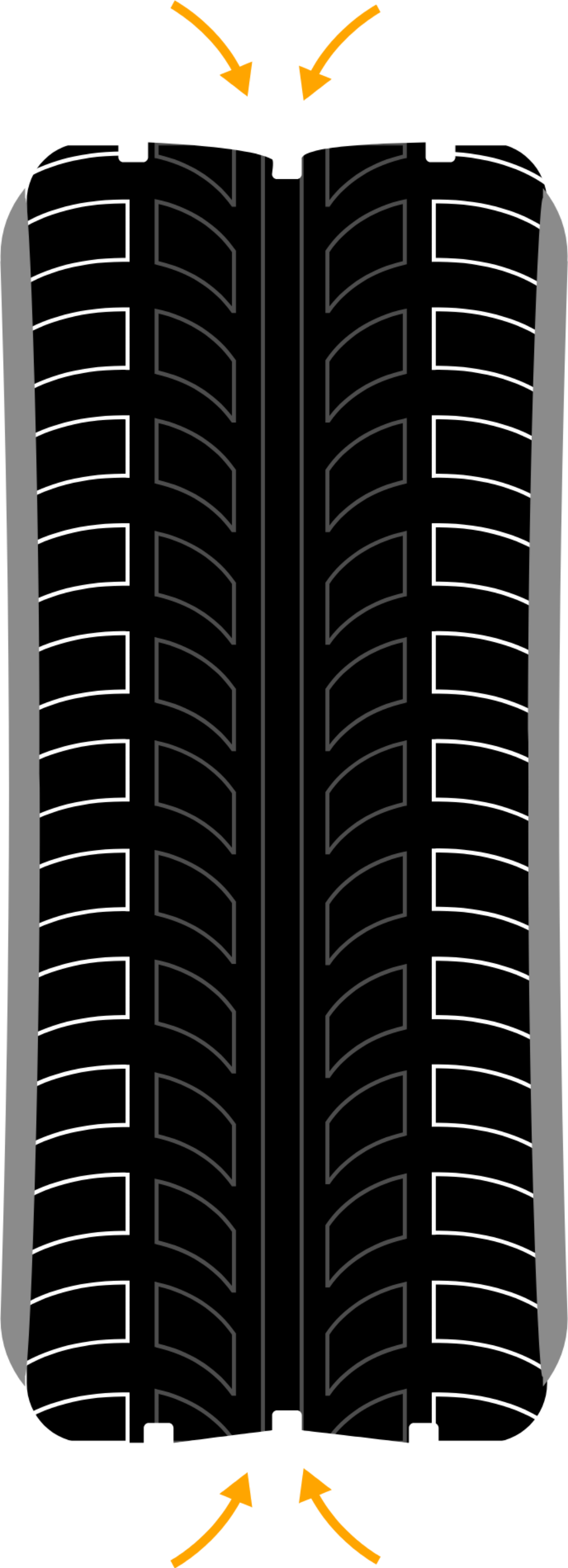
# Tyre Damages and Age
Flat-spotting
Flat spots from long-term parking and storage
It’s not uncommon for some of us to leave our cars parked for long stretches spanning days, weeks – sometimes even months. If you’re one of these people, you may notice a slight ride disturbance or vibration the first time you drive the car, but it will usually disappear after a few miles of driving.
This phenomenon is known as flat-spotting, a condition that occurs when a tyre has been stationary under vehicle load for a prolonged period. The tyre has a flat spot in the area where it was in contact with the ground. Alarmed? Don’t be. Let’s dive into the causes of flat-spotting in a little more detail, plus tips on how to prevent it.

From rolling tyres to flat spots
As you drive your car, each tyre rapidly rotates on the wheel from a “relaxed state” to a “loaded state” approximately 300 times per mph or 480 times per kilometre (depending on your speed). This constant motion generates heat, which makes the rubber in the tyres more supple – this is standard behaviour for your tyres.
Once you’ve stopped and parked your car, however, the contact patch of the tyre can flatten slightly where it is in contact with the ground as the tyres cool down. It’s especially likely to occur when the tyres experience a dramatic swing in ambient temperatures, the car is parked overnight in cold temperatures or the vehicle is in storage for a long time. Another factor is tyre pressure, and whether the tyres are underinflated or overloaded.
There are two types of flat-spotting: temporary and semi-permanent. The severity of a tyre flat spot will depend on factors like size, load, internal structure, the ambient temperature and the amount of time it is stationary.
Temporary vs. semi-permanent flat-spotting
In the majority of cases, flat-spotting is temporary. If a vehicle has been stationary for a few days or weeks – for example, if you’ve been away on holiday and parked the car at the airport – drivers may experience some slight vibrations during the first few miles of their journey. The flat spots will disappear once the tyres have reached their operational temperature and regained their normal shape.
Semi-permanent flat-spotting will occur if the tyres have been standing still under vehicle load for a month or longer. A typical situation where this can happen is if you’re storing your vehicle away for the winter months, or if it’s being transported overseas. The long standing times, especially in tandem with high temperatures and low tyre pressure, can result in more severe flat-spotting that normal driving won’t remedy.
If you suspect that your tyres have semi-permanent flat-spotting, you should contact your local tyre specialist or garage in the first instance, and they’ll guide you through the options on how to fix it.

Tips to prevent temporary flat-spotting
Maintaining the correct tyre pressure is an effective strategy to mitigate the chances of flat-spotting happening.
Tyres that are underinflated are more susceptible to a flat spot, and it’s generally advisable not to operate your tyres when they’re underinflated or overloaded.
If you’re about to undertake a long-distance journey at high speeds with heavy loads, then you should increase the inflation pressure of your tyres in line with the vehicle manufacturer’s recommendations.
Did you know that a slight increase of 3 PSI in tyre inflation pressure results in lower tyre running temperatures? In turn, this decreases the likelihood of flat-spotting.
Similarly, if you’re about to park your car for a long time without driving, then slightly increasing the inflation pressure of the tyres by 3 PSI before parking will help to reduce the chances of flat-spotting.
In both instances, however, it’s important to remember that you should never exceed the maximum recommended cold inflation pressure for your tyres.
Related content
-
 2022/08/05Replacing tyresHow long will tyres last before you should replace them? It depends on the tread design of the tyre, road conditions, and how frequently the car is in use.Read more
2022/08/05Replacing tyresHow long will tyres last before you should replace them? It depends on the tread design of the tyre, road conditions, and how frequently the car is in use.Read more -
 2022/09/02Tyre damagesTyres can become damaged, and it can happen without the driver realising there's an issue. We explain the signs and symptoms to help diagnose the problem.Read more
2022/09/02Tyre damagesTyres can become damaged, and it can happen without the driver realising there's an issue. We explain the signs and symptoms to help diagnose the problem.Read more -
 2022/08/05Flat-spottingFlat-spotting occurs when a tyre has been stationary under vehicle load for a prolonged period. Let’s explore the causes, plus tips on how to prevent it.Read more
2022/08/05Flat-spottingFlat-spotting occurs when a tyre has been stationary under vehicle load for a prolonged period. Let’s explore the causes, plus tips on how to prevent it.Read more